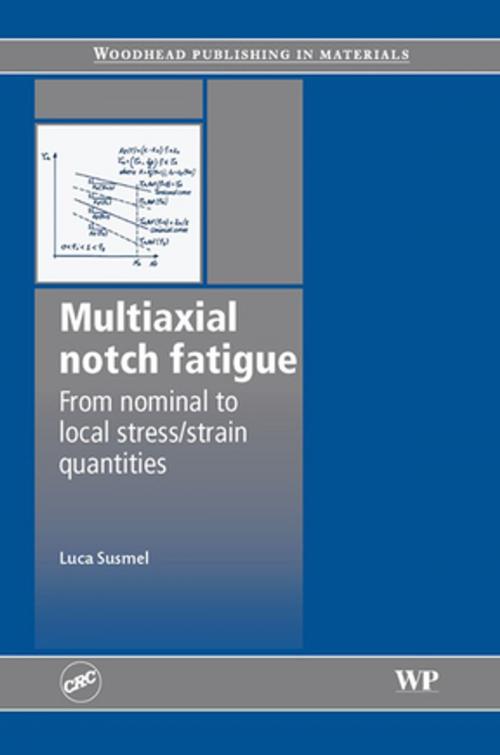| Author: | Luca Susmel | ISBN: | 9781845695835 |
| Publisher: | Elsevier Science | Publication: | March 20, 2009 |
| Imprint: | Woodhead Publishing | Language: | English |
| Author: | Luca Susmel |
| ISBN: | 9781845695835 |
| Publisher: | Elsevier Science |
| Publication: | March 20, 2009 |
| Imprint: | Woodhead Publishing |
| Language: | English |
Metal and composite components used in structural engineering not only contain geometrical features resulting in stress concentration phenomena, but they are also subjected to in-service multiaxial fatigue loading. To address the problem, structural engineers need reliable methodologies which allow for an adequate margin of safety. The book summarises methods devised by the author to design real components against multiaxial fatigue by taking full advantage not only of nominal but also of local stress-strain quantities.
The book begins by reviewing definitions suitable for calculating the stress-strain quantities commonly used to perform fatigue assessment. The Modified Wöhler Curve Method is then explained in detail, by focusing attention on both the high- and the medium-cycle fatigue regime. The existing links between the multiaxial fatigue criterion and physical properties are also discussed. A procedure suitable for employing the method developed by the author to estimate fatigue damage both in notched and in welded components is explained. The Modified Manson-Coffin Curve method is investigated in depth, by reviewing those concepts playing a fundamental role in the so-called strain based approach. Lastly, the problem of performing the fatigue assessment of composite materials is addressed by considering design parameters influencing composite behaviour under complex cyclic loading paths and those criteria suitable for designing real components against multiaxial fatigue. The book also contains two appendices summarising experimental data from the technical literature. These appendices provide a unique and highly valuable resource for engineers. The appendices summarise around 100 values of the material characteristic length L, experimentally determined by testing specimens made of different engineering materials and about 4500 experimental fatigue results generated by testing plain, notched and welded specimens under constant-amplitude proportional and non-proportional multiaxial fatigue loading are listed.
- Summarises methods devised by the author to design real components against multiaxial fatigue
- Reviews definitions suitable for calculating the stress-strain quantities commonly used to perform fatigue assessment
- Includes an in-depth explanation of both the Modified Wöhler Curve and Modified Manson-Coffin Curve Method
Metal and composite components used in structural engineering not only contain geometrical features resulting in stress concentration phenomena, but they are also subjected to in-service multiaxial fatigue loading. To address the problem, structural engineers need reliable methodologies which allow for an adequate margin of safety. The book summarises methods devised by the author to design real components against multiaxial fatigue by taking full advantage not only of nominal but also of local stress-strain quantities.
The book begins by reviewing definitions suitable for calculating the stress-strain quantities commonly used to perform fatigue assessment. The Modified Wöhler Curve Method is then explained in detail, by focusing attention on both the high- and the medium-cycle fatigue regime. The existing links between the multiaxial fatigue criterion and physical properties are also discussed. A procedure suitable for employing the method developed by the author to estimate fatigue damage both in notched and in welded components is explained. The Modified Manson-Coffin Curve method is investigated in depth, by reviewing those concepts playing a fundamental role in the so-called strain based approach. Lastly, the problem of performing the fatigue assessment of composite materials is addressed by considering design parameters influencing composite behaviour under complex cyclic loading paths and those criteria suitable for designing real components against multiaxial fatigue. The book also contains two appendices summarising experimental data from the technical literature. These appendices provide a unique and highly valuable resource for engineers. The appendices summarise around 100 values of the material characteristic length L, experimentally determined by testing specimens made of different engineering materials and about 4500 experimental fatigue results generated by testing plain, notched and welded specimens under constant-amplitude proportional and non-proportional multiaxial fatigue loading are listed.
- Summarises methods devised by the author to design real components against multiaxial fatigue
- Reviews definitions suitable for calculating the stress-strain quantities commonly used to perform fatigue assessment
- Includes an in-depth explanation of both the Modified Wöhler Curve and Modified Manson-Coffin Curve Method















